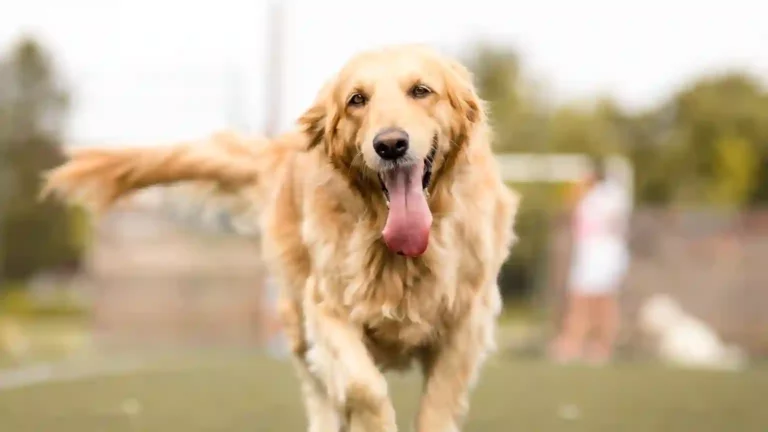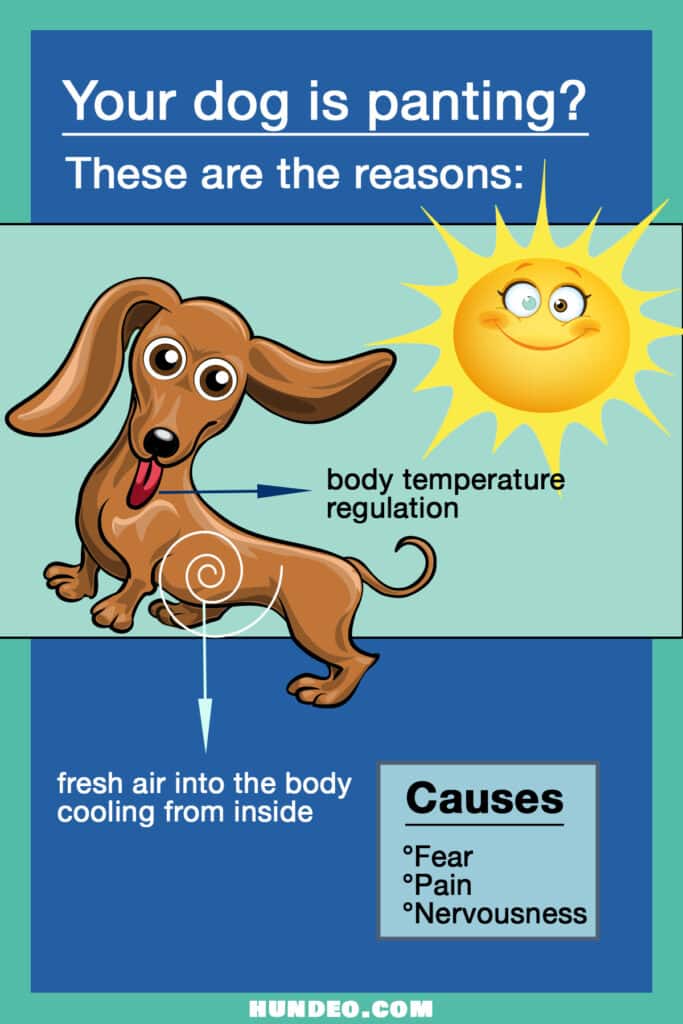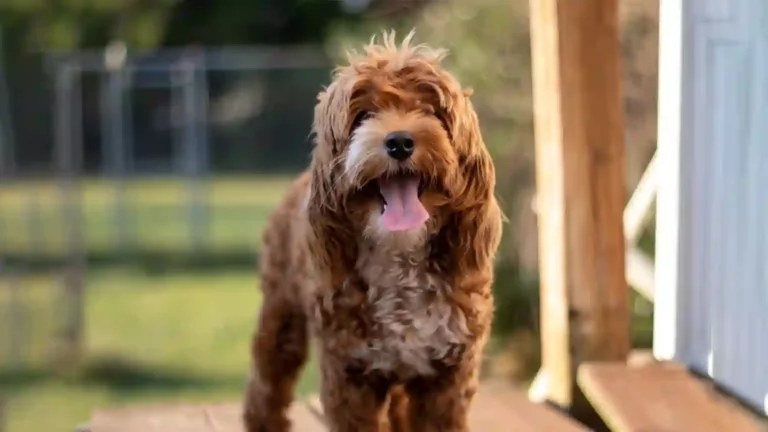Excessive Panting in Dogs: Common Causes
- Veterinarian Mag.med.vet. Emin Jasarevic
- Updated: 2023-08-16
When can panting be a sign of pain? What can you do as a dog owner? You'll find out here! In addition, for this article we have advice from veterinarian Mag.med.vet. Emin Jasarevic. So be curious!

When we think of dogs, we may also think of our pets' famous panting. Surely each of us has observed it at least once.
Sometimes this panting is almost dangerous for the dog. Add a loud snort and many dog owners get scared.
Basically, panting is part of a dog's normal breathing. Just as we sometimes run out of breath, so can our four-legged friend.
Meaning and Symptoms
The regulation of body temperature in the dog is largely controlled by the upper respiratory tract. The upper respiratory tract includes the pharynx, nasal cavity, larynx, and trachea.
Unlike humans, our dogs have few sweat glands on their bodies. The few sweat glands are located on the paw pads and nose leather. Panting allows fresh air to enter the animal's body, cooling it from the inside out.
In principle, this method is similar to how we sweat. However, it is not as effective as for humans.
In any case, make sure your pet has fresh water and a shady place to rest. This will help him recover more quickly after strenuous activities.
In the height of summer, don't go for midday walks and wild play adventures, but wait for the cooler evening hours.
Dogs themselves know when they have had enough of playing, but the blazing sun is not good for them.
If you do decide to go for a walk in the blazing sun, make sure your pet is not overexerting himself.
After the walk, make sure there is plenty of water and shade. You should also take a few short breaks to keep your pet from overexerting himself.
Heavy Breathing and Panting Explained
In the "dead space" that extends from the mouth up to and including the trachea, much more air circulates due to the panting mechanism. However, this air does not reach the lungs.
This process is not about providing cold air to the dog, but rather allowing the liquid to evaporate through this constant flow of air.
Evaporative heat is extracted, similar to human sweating. This causes the animal's body temperature to drop. At normal temperature, the dog can take up to 30 or even 40 breaths per minute.
When he exerts himself or is exposed to great heat, he reaches 300 to 400 breaths. This means that your protégé increases his breathing rate tenfold.
Evolution has created a very efficient system! But what makes this frequency possible?
There are two reasons for this: Saliva production is designed for the so-called "drooling" that we know all too well from dogs. His tongue does not dry out as it does in humans. In addition, dogs breathe much more shallowly than humans.
So dogs do not hyperventilate when they pant. A human would not be able to take that many breaths per minute.

Do Large or Small Dogs Pant More?
Interestingly, panting varies from dog to dog, and especially from breed to breed.
Small dogs pant less because they have a smaller body volume. This allows the temperature to be controlled more quickly.
Large dogs need to pant much more to avoid overheating. The drooling and panting is therefore much more intense than in their smaller counterparts.
Panting can be a problem in short-nosed breeds. This includes the Pug. Breeding has shortened the airways so the animal cannot pant well.
During periods of intense heat or play, you will need to pay special attention to the panting of this breed. You should also keep a close eye on your Pug during long walks.
Causes

Fear and Pain
Dogs may pant not only to cool down, but also out of fear and nervousness.
Some dogs are very afraid of thunderstorms or cannot stand the noise of fireworks.
The animals can really panic, which can be seen by the wide open eyes. This is usually accompanied by short gasps.
In most cases, panting itself is not a cause for alarm, but you should still pay attention to why the animal is panting. If it is due to anxiety, you may want to gently reassure it to take away some of the anxiety.
Not only fear, but also pain. can be a reason for panting, especially in older dogs.
So constant panting for no apparent reason can be a sign of pain. Your dog's body language is crucial in determining whether it is real pain, anxiety, or something else.
If your dog is panting excessively, it is imperative that you see a veterinarian to have the problem diagnosed!
Dog Panting While Resting
Panting is a normal means of heat regulation in dogs. However, if your dog is panting at rest for no apparent reason, there may be several causes:
- Overheating: Even if your dog is calm, he may become overheated, especially after exercise or in high temperatures.
- Stress or Anxiety: Dogs sometimes pant when they are stressed or anxious. This can be triggered by environmental factors, new situations or noise.
- Pain: Some dogs pant when they are in pain. This may indicate a hidden injury or health problem.
- Heart problems: Heart disease can cause dogs to pant more often because the heart is not working efficiently enough to deliver oxygen to the body.
- Respiratory diseases: Diseases of the lungs or airways can make breathing difficult and cause increased panting.
- Cushing's syndrome: This is a disease of the adrenal glands in which too much corticosteroid is produced. Wheezing may be a symptom.
- Medication: Some medications may cause increased panting.
- Overweight: Overweight dogs often have difficulty regulating their body temperature, which can lead to increased panting.
- Pregnancy or heat: Hormonal changes can also cause increased panting.
If your dog is panting at rest for no apparent reason, it is important to see your veterinarian. He can determine the exact cause and recommend appropriate treatment.
It is always better to be safe than sorry, and to seek professional advice when dealing with unexplained behavior.
Dog Panting During Petting
If your dog pants when you pet him, it could be for a number of reasons. Here are some reasons why dogs may pant in these situations:
- Relaxation and well-being: Some dogs pant slightly when they are relaxed and comfortable, much like people sigh when they are content.
- Nervousness or insecurity: If a dog is uncomfortable in a certain environment or with certain people, it may pant to show its stress or nervousness.
- Overstimulation: Sometimes petting, especially if it is intense or in sensitive areas, can overstimulate the dog and cause it to pant.
- Connection with previous experiences: If a dog has had negative experiences with humans in the past, it may pant when petted out of fear or insecurity.
- Health reasons: If the dog pants frequently, even when not being petted, this may be a sign of health problems. It is important to be aware of other symptoms and to consult a veterinarian when in doubt.
- Warm environment: If the room is warm or poorly ventilated, the dog may pant regardless of petting.
To understand why the dog is panting in this situation, it is important to observe the dog's overall behavior and body language.
Does he show other signs of relaxation, such as a limp body and wagging tail? Or does he show signs of nervousness by putting his ears back or avoiding eye contact?
By interpreting all of your dog's body language, you can better understand how he is feeling right now. However, if you are concerned or unsure about your dog's behavior, it is always a good idea to consult a veterinarian or behaviorist.
Dog Panting in Car
Your dog's panting in the car can have several causes. Here are some possible causes:
- Stress or Anxiety: Driving is stressful for many dogs, especially if they are not used to it or have had bad experiences. Panting can be a sign that the dog is scared or anxious.
- Nausea: Some dogs become nauseous in the car. In addition to panting, this can be a sign that the dog is restless, salivating or even vomiting.
- Excitement: Some dogs just get excited in the car, perhaps because they know they are going to an exciting place like a park or the beach.
- Overheating: Cars can heat up quickly, even if it's not particularly warm outside. Your dog may pant because he is too warm. It is very important never to leave a dog in a parked car, even for a short time.
- Respiratory diseases: Some health problems may cause your dog to pant more than usual, even in the car.
- Age: Older dogs may be more sensitive to changes in their environment and may pant more for a variety of reasons.
If your dog is panting in the car, it's important to consider the context. If he is showing signs of stress or anxiety, gradual desensitization and counter-conditioning exercises may help reduce his fear of driving.
If overheating is the problem, make sure the car is well ventilated and avoid driving on hot days.
If you are concerned about your dog's health, it is always a good idea to consult a veterinarian.
When Is Panting a Problem?
Panting is a normal and natural way for dogs to cool themselves and increase oxygen levels in the blood. However, there may be situations where panting is a cause for concern.
Here are some situations where your dog's panting may be a cause for concern:
- Excessive panting for no apparent reason: If your dog is panting more heavily or more frequently than normal for no apparent reason (e.g., heat or exercise), this should be investigated.
- Panting along with other symptoms: If panting is accompanied by other symptoms such as listlessness, disorientation, vomiting, diarrhea, or other noticeable behavioral changes.
- Panting after little or no exertion: If your dog pants with little exertion or at rest, it may be a sign of a health problem.
- Changes in the hackle pattern: Sudden or persistent panting that is different from normal panting may be of concern.
- Panting in a cold environment: If it's chilly and your dog is panting for no reason, it could be a sign of pain, anxiety, or other health problems.
- Panting at night: If your dog pants at night and there is no obvious explanation for it (such as heat or excitement), it may be a sign of a health problem.
- Panting in older dogs: Older dogs often have health problems that can cause increased panting, such as heart problems, lung problems, or other diseases.
If you're concerned about your dog's panting, it's always a good idea to see your veterinarian.
A veterinarian can determine the exact cause and make appropriate treatment or husbandry recommendations. It is better to be safe than sorry and take your dog's health seriously.
Frequently Asked Questions
Dogs have very few sweat glands to regulate their temperature like humans do. Therefore, dogs must regulate their temperature by panting.
If your dog is overheated from hot weather or exercise, it's normal for him to pant a lot. If there is no obvious trigger for the panting, you should monitor your dog and possibly take him to the vet.
If your dog pants for no reason or pants excessively, he may be overheating. Pugs, for example, are particularly vulnerable. They can easily overheat. If your dog is panting a lot, be sure to cool him down and give him a break.
Veterinarian’s Recommendation
You're probably familiar with dog panting, which is usually accompanied by heavy salivation.
Panting is completely normal in quadrupeds and is nothing to worry about. It is the animal's way of cooling down its body temperature.
So it's normal for your dog to start panting after long walks, strenuous activity, wild play or in the heat.
It is important to keep an eye on him and provide adequate shade and fluids.
Fear and nervousness can also cause a dog to pant heavily. This can be seen in some dogs on New Year's Eve or during a thunderstorm. At such times, it is important to calm the animal.
Panting can be dangerous in small breeds or when it occurs for no apparent reason.
Then it may be a sign of pain and you should definitely see a vet!

I am a veterinarian and writer on animal health topics. Animals are my passion, and it is my personal goal to create medically accurate articles and videos to educate pet owners as much as possible.
Share Now:

